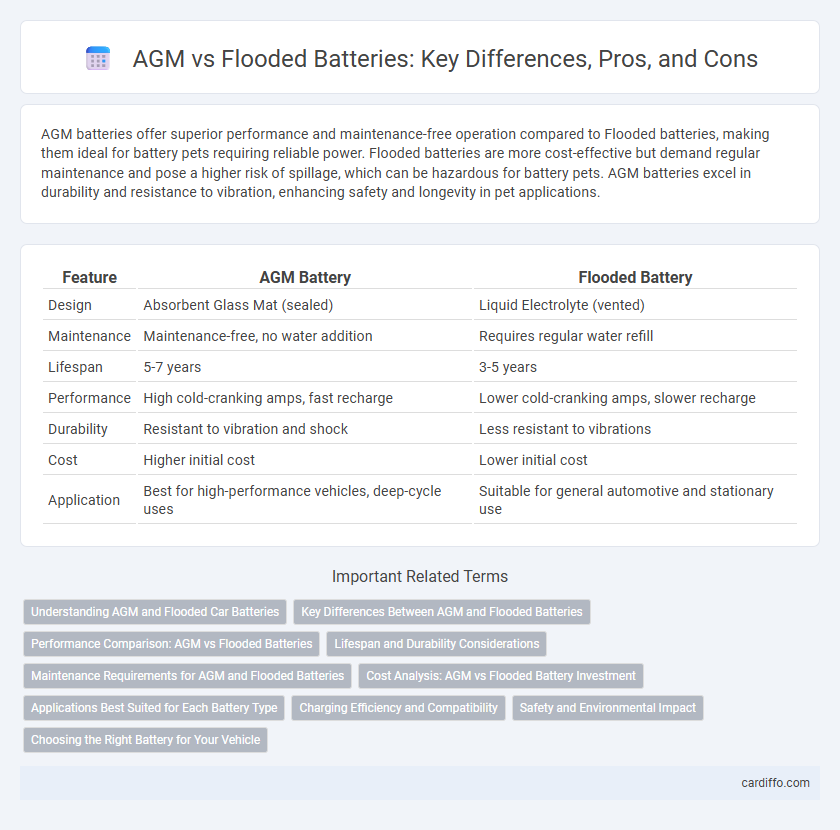AGM batteries offer superior performance and maintenance-free operation compared to Flooded batteries, making them ideal for battery pets requiring reliable power. Flooded batteries are more cost-effective but demand regular maintenance and pose a higher risk of spillage, which can be hazardous for battery pets. AGM batteries excel in durability and resistance to vibration, enhancing safety and longevity in pet applications.
Table of Comparison
| Feature | AGM Battery | Flooded Battery |
|---|---|---|
| Design | Absorbent Glass Mat (sealed) | Liquid Electrolyte (vented) |
| Maintenance | Maintenance-free, no water addition | Requires regular water refill |
| Lifespan | 5-7 years | 3-5 years |
| Performance | High cold-cranking amps, fast recharge | Lower cold-cranking amps, slower recharge |
| Durability | Resistant to vibration and shock | Less resistant to vibrations |
| Cost | Higher initial cost | Lower initial cost |
| Application | Best for high-performance vehicles, deep-cycle uses | Suitable for general automotive and stationary use |
Understanding AGM and Flooded Car Batteries
AGM (Absorbent Glass Mat) batteries feature a sealed design with electrolyte absorbed in fiberglass mats, providing enhanced vibration resistance and faster charging compared to traditional flooded batteries. Flooded batteries contain a liquid electrolyte and require regular maintenance, such as checking water levels, making them less suitable for high-vibration environments and deep cycling. Understanding the construction and maintenance requirements of AGM versus flooded car batteries helps determine the best choice for specific vehicle needs and usage conditions.
Key Differences Between AGM and Flooded Batteries
AGM batteries utilize absorbed glass mat separators to immobilize the electrolyte, offering superior vibration resistance and maintenance-free operation compared to flooded batteries, which contain liquid electrolyte requiring regular water replenishment. Flooded batteries typically have a lower upfront cost and longer service life under moderate cycling but are more prone to spillage and corrosion due to their open design. AGM batteries feature faster recharge times and better cold-weather performance, making them ideal for applications demanding higher durability and reliability.
Performance Comparison: AGM vs Flooded Batteries
AGM batteries provide superior performance with faster recharge times, higher energy density, and better resistance to vibration compared to flooded batteries. Flooded batteries often have a longer cycle life under deep discharge conditions but require regular maintenance and proper ventilation due to electrolyte spillage risks. AGM technology excels in applications demanding durability, low maintenance, and efficient power delivery across extreme temperatures.
Lifespan and Durability Considerations
AGM batteries typically offer a longer lifespan of 4 to 7 years due to their sealed design, which reduces the risk of acid spillage and corrosion. Flooded batteries generally last 3 to 5 years but require regular maintenance such as water top-ups to prevent sulfation and extend durability. In environments with frequent vibrations or extreme temperatures, AGM batteries provide superior durability and reliability compared to flooded alternatives.
Maintenance Requirements for AGM and Flooded Batteries
AGM batteries require minimal maintenance since they are sealed and do not need water refilling, making them ideal for users seeking hassle-free power solutions. Flooded batteries demand regular inspection and water replenishment to maintain electrolyte levels and prevent sulfation, which can extend battery life. Maintaining proper electrolyte balance in flooded batteries is crucial for performance but adds complexity compared to the maintenance-free nature of AGM batteries.
Cost Analysis: AGM vs Flooded Battery Investment
AGM batteries typically have a higher upfront cost compared to flooded batteries due to their advanced design and sealed construction. Flooded batteries offer a lower initial investment but require regular maintenance and have a shorter lifespan, which can increase long-term costs. Evaluating total ownership expenses including replacement frequency, maintenance, and efficiency reveals that AGM batteries often provide better value despite higher initial prices.
Applications Best Suited for Each Battery Type
AGM batteries excel in applications requiring maintenance-free operation and high vibration resistance, making them ideal for motorcycles, marine vessels, and backup power systems. Flooded batteries are best suited for traditional automotive use, golf carts, and renewable energy storage where regular maintenance is feasible and cost efficiency is prioritized. The choice depends on specific needs such as durability, cost, and maintenance capabilities.
Charging Efficiency and Compatibility
AGM batteries offer higher charging efficiency due to lower internal resistance compared to flooded batteries, enabling faster energy absorption and reduced charging time. Their sealed design ensures compatibility with modern smart chargers that use precise voltage regulation, minimizing the risk of overcharging and extending battery lifespan. Flooded batteries require slower, controlled charging to prevent electrolyte loss and are less compatible with rapid charging systems, often needing maintenance to ensure optimal performance.
Safety and Environmental Impact
AGM batteries offer enhanced safety with a sealed design that prevents acid spills and reduces the risk of leakage, making them less hazardous compared to flooded batteries. Flooded batteries require regular maintenance to avoid acid leaks, which can pose environmental risks due to soil and water contamination. The sealed nature of AGM batteries also minimizes gas emissions, contributing to a safer and more environmentally friendly energy storage solution.
Choosing the Right Battery for Your Vehicle
AGM (Absorbent Glass Mat) batteries offer superior vibration resistance and faster charging, making them ideal for vehicles with high electrical demands and stop-start systems. Flooded batteries are cost-effective with proven reliability but require regular maintenance and proper ventilation due to liquid electrolyte. Choosing the right battery depends on your vehicle's power needs, maintenance willingness, and budget considerations to ensure optimal performance and longevity.
AGM vs Flooded Infographic

 cardiffo.com
cardiffo.com